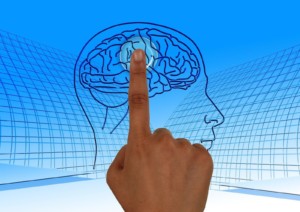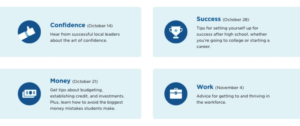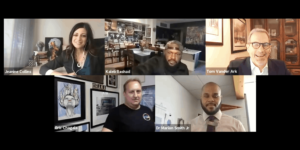A New Spin on Education: Cognitive Capacity for an Uncertain Future
Key Points
-
The goal is cognitive literacy, that is, learning how to learn.
-
Every child should have an opportunity to develop and strengthen their cognitive skills to their potential.

By: Betsy Hill and Roger Stark
School days, school days, dear old golden rule days. When “readin’ and ‘ritin’ and ‘rithmetic” were “taught to the tune of a hick’ry stick.”
What the Hay? Can you believe there was a time when we actually sang this, and we didn’t bat an eye?
In our last installment, we wrote that in these days of brain science, many long-standing assumptions about education are being called into question and the fact that the model of education that arose to address the industrial age has been asked to prepare students for the “ages” that have come in quick succession – the “information age,” the “digital age,” the “experience age” and whatever will come next.
Of course, the fact of the matter is that we don’t know what comes next. So rather than train learners with information that may or may not prove useful in their chosen field (especially if that field hasn’t been invented yet), we build learners’ cognitive abilities so they can master whatever comes next.
Imagine how much easier it would be for teachers if every student was just a wee bit smarter, and if learning came a wee bit easier.
Science fiction, you say? Well, you’d be half right.
It’s science.
Perhaps instead of leading with the lyrics of the 1907 hit School Days, we should have led with the 1985 classic from Oingo Boingo, Weird Science. And if you were teaching in 1985, brain science may have been a bit weird. But in today’s world, there is nothing weird about neuroscience.
We used to think the world was flat. And the earth was the center of the universe. And IQ was fixed. But when the Nina, the Pinta and the Santa Maria sailed across the world, no one fell off the edge. A telescope and 6th-grade math will tell you that the earth orbits the sun. And the right kind of cognitive training can make you smarter.
When we started our company some years ago, we decided to utilize video-game technology to aid in cognitive training. At that time, it felt a bit like Copernicus and his telescope. To say the least, we were a little ahead of our time.
We decided to put leading clinicians in the same room with top video-game designers. Well, we quickly found that they didn’t even speak the same language. The clinicians would speak, and the gamers would bring back, well, “weird science.” It was maddening and would have been hilarious if we weren’t spending our families’ life savings to get this done. But eventually, they began to communicate, and just 14 years later, the work has become almost mainstream.
Most importantly, the work works.
Tom Hughes, principal of Maple Crest STEM Middle School uses cognitive training in his school. He says, “When you start watching kids on the cognitive training program, and the skills that are being taught – as an educator, I just don’t know how to teach those. We just assumed they learned those skills along the way, the same way we assumed they learned responsibility along the way (which they didn’t). I did absolutely everything I could to get more kids to make the gains that we saw, and we continue to see.”
Pat Crone, a teacher at Urey Middle School, says, “As a teacher, the number one thing you want to see is the light turn on in the eyes of the student and then shine brightly in all the other classes. With cognitive training, I saw that in a number of our students. That light switch flipped for them. They got more confident, and they were excited.”
The goal is cognitive literacy, that is, learning how to learn.
Betsy Hill and Roger Stark
But just what is it that cognitive training is supposed to do for our learners?
When students struggle with learning, the problem is often not a matter of curriculum and instruction. On this front, educators often get a bad rap. Of course, sometimes instructional practice and teacher effectiveness are at fault, but learner variability – the fact that we all have cognitive strengths and weaknesses – means that just about every learner needs support in one or more areas of cognitive processing.
The goal is cognitive literacy, that is, learning how to learn. Using a comprehensively integrated architecture to build cognitive literacy means that students have the underlying cognitive capacity for learning. And this is the deeper and more urgent implication of cognitive literacy in our world today. Our children and grandchildren cannot hope to memorize how to do what they will need to do in their future roles and careers. They will have to learn what to do – and then learn again what to do – as circumstances and the demands of the world change. Every student should understand his or her cognitive strengths and weaknesses. Every student should have a personalized toolkit of strategies, practices and supports. Every child should have an opportunity to develop and strengthen their cognitive skills to their potential.
Cognitive literacy means that a student can learn, that they have the skills in attention, memory, perceptual processing, core and higher-order executive functions – an efficiently functioning brain, if you will – to see them through the repeated demands for learning that they will experience in their lives.
When students’ ability to learn improves, many good things start to happen. Their confidence improves, and their emotional well-being becomes markedly better. As this happens, teachers report that teaching becomes more enjoyable, which is vitally important during this time of teacher shortages.
Also, students’ academic outcomes improve, which goes a long way toward keeping them involved in traditional schooling, curbing student attrition and combatting the trend glorified in a 2014 song by Charli XCX, with teens singing, “I don’t wanna go to school. I just wanna break the rules.”
Talk about a win/win/win. Preparing students to thrive in an unknowable future.
In our next column, we will talk about the C-Factor and what that means. If you haven’t heard of the C-Factor yet, odds are you’ll be hearing about it soon. And often.
Betsy Hill is President of BrainWare Learning Company, a company that builds learning capacity through the practical application of neuroscience. She is an experienced educator and has studied the connection between neuroscience and education with Dr. Patricia Wolfe (author of Brain Matters) and other experts.
Roger Stark is Co-founder and CEO of the BrainWare Learning Company. Over the past decade, he championed efforts to bring comprehensive cognitive literacy skills training and cognitive assessment within reach of every person, and it all started with one very basic question: What do we know about the brain?





0 Comments
Leave a Comment
Your email address will not be published. All fields are required.